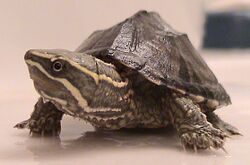Biology:Americhelydia
From HandWiki
Short description: Clade of turtles
| Americhelydia | |
|---|---|

| |
| Common musk turtle (Sternotherus odoratus), a species of the family Kinosternidae | |
| Scientific classification | |
| Domain: | Eukaryota |
| Kingdom: | Animalia |
| Phylum: | Chordata |
| Class: | Reptilia |
| Order: | Testudines |
| Suborder: | Cryptodira |
| Clade: | Americhelydia Crawford et al., 2014 |
| Subclades | |
| |
Americhelydia is a clade of turtles that consists of sea turtles, snapping turtles, the Central American river turtle and mud turtles, supported by several lines of molecular work.[4][5][6] Prior to these studies some morphological and developmental work have considered sea turtles to be basal members of Cryptodira and kinosternids related to the trionychians in the clade Trionychoidea.[7][8] Americhelydia and Testudinoidea, both clades within Durocryptodira (hardshell turtles), split a part during the early Cretaceous.[9][10]
References
- ↑ Joyce, W. G., Parham, J. F., Lyson, T. R., Warnock, R. C., & Donoghue, P. C. (2013). A divergence dating analysis of turtles using fossil calibrations: an example of best practices. Journal of Paleontology, 87(04), 612-634.
- ↑ "Protostegidae". The Paleobiology Database. http://paleodb.org/?a=checkTaxonInfo&taxon_no=37689.
- ↑ Edwin A. Cadena and James F. Parham (2015). "Oldest known marine turtle? A new protostegid from the Lower Cretaceous of Colombia". PaleoBios 32 (1): 1–42. http://escholarship.org/uc/item/147611bv.
- ↑ Chandler, C. H., & Janzen, F. J. (2009). The phylogenetic position of the snapping turtles (Chelydridae) based on nucleotide sequence data. Copeia, 2009(2), 209-213.
- ↑ Barley, A. J., Spinks, P. Q., Thomson, R. C., & Shaffer, H. B. (2010). Fourteen nuclear genes provide phylogenetic resolution for difficult nodes in the turtle tree of life. Molecular Phylogenetics and Evolution, 55(3), 1189-1194.
- ↑ Crawford, N. G., Parham, J. F., Sellas, A. B., Faircloth, B. C., Glenn, T. C., Papenfuss, T. J., ... & Simison, W. B. (2015). A phylogenomic analysis of turtles. Molecular Phylogenetics and Evolution, 83, 250-257.
- ↑ Joyce, W. G. (2007). Phylogenetic relationships of Mesozoic turtles. Bulletin of the Peabody Museum of Natural History, 48(1), 3-102.
- ↑ Werneburg, I., & Sánchez-Villagra, M. R. (2009). Timing of organogenesis support basal position of turtles in the amniote tree of life. BMC Evolutionary Biology, 9(1), 82.
- ↑ Pereira, Anieli G.; Sterli, Juliana; Moreira, Filipe R.R.; Schrago, Carlos G. (August 2017). "Multilocus phylogeny and statistical biogeography clarify the evolutionary history of major lineages of turtles". Molecular Phylogenetics and Evolution 113: 59–66. doi:10.1016/j.ympev.2017.05.008. ISSN 1055-7903. PMID 28501611. http://dx.doi.org/10.1016/j.ympev.2017.05.008.
- ↑ Joyce, Walter G.; Rabi, Márton; Clark, James M.; Xu, Xing (2016-10-28). "A toothed turtle from the Late Jurassic of China and the global biogeographic history of turtles". BMC Evolutionary Biology 16 (1): 236. doi:10.1186/s12862-016-0762-5. ISSN 1471-2148. PMID 27793089.
Wikidata ☰ Q28431972 entry
 |

